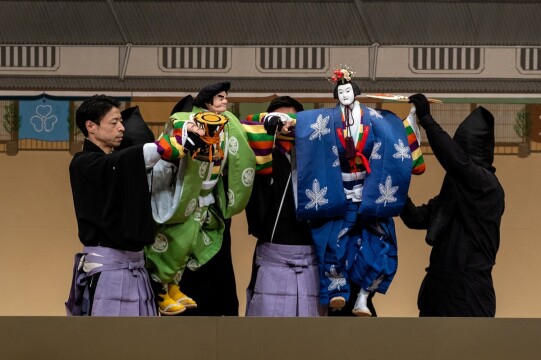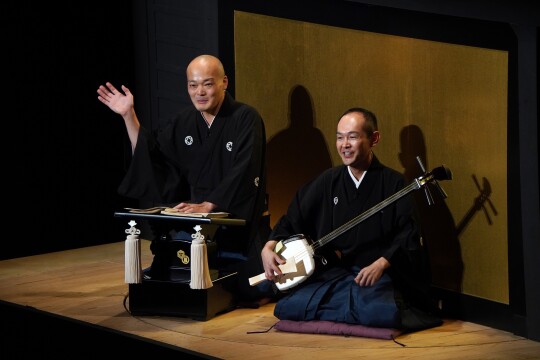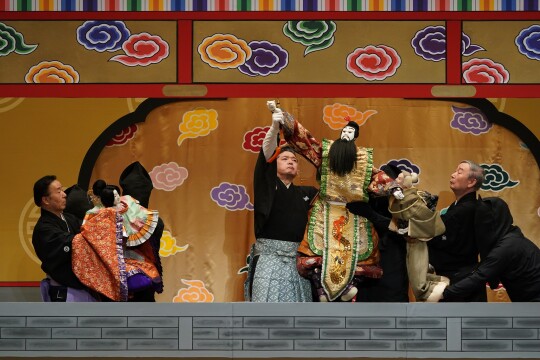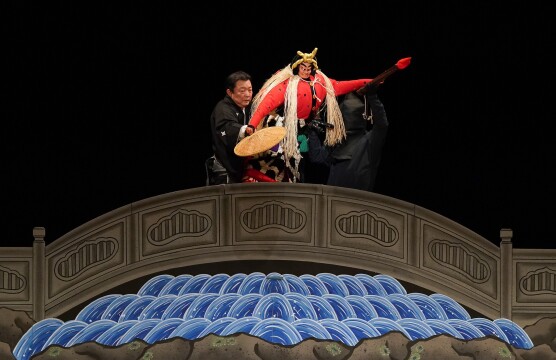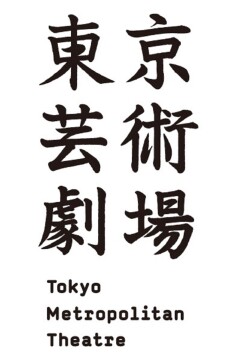
The National Theatre, which has produced and presented many traditional performing arts performances, is currently hosting performances at various theaters in the Tokyo metropolitan area. This time, for the first time, a Bunraku performance will be held at the Tokyo Metropolitan Theatre Playhouse, located in Ikebukuro, Toshima Ward, one of Tokyo's most important terminals.
The National Theatre has been holding Bunraku Appreciation Classes since 1969, where performers provide commentary and performers present famous scenes that represent Bunraku, so that even first-time viewers can fully enjoy its charm. There are two performances per day, with a double cast featuring different roles for each performance. Also on offer are "Introduction to Bunraku for Adults" (5th and 6th), which starts at 6pm and is convenient for those who are busy during the day or on weekdays, and "Discover BUNRAKU – Bunraku Appreciation Class for Foreigners" (17th), which offers extensive support in English.
The curtain opens with "Manzai," a fun introduction to the world of Bunraku.
"Hanakurabeshikino Kotobuki" is a keigoto piece (a performance in which the musical performance has more melodic parts than dialogue, and the puppet performance is more dance-like) that depicts the four seasons of the Kinki region in four scenes: spring, summer, autumn, and winter. The piece you will see today is the spring scene from the piece. The choreography was done by Rikuhei Umemoto, third-generation head of the Umemoto school of Kamigatamai dance, and it is a celebratory act in which two performers celebrate the New Year against the backdrop of the Kyoto cityscape.
“Banzai''
It's New Year's in Kyoto, and the streets are lined with kadomatsu decorations, creating a refreshing atmosphere. Entertaining them is the arrival of two entertainers, Tayu and Saizō. To celebrate the New Year, the two perform a celebratory dance accompanied by the gentle sound of drums, praying for prosperity in business and for the prosperity of their descendants.
"Explanation: The Charm of Bunraku" is a fun demonstration that even beginners can enjoy.
The performers will convey the charm of Bunraku through demonstrations.
Chikamatsu Monzaemon's masterpiece "The Battle of Kokusenyakassen" exudes an exotic atmosphere
This five-act period piece by Chikamatsu Monzaemon premiered at the Osaka Takemotoza in November 1715. The previous year, Chikamatsu's ally, the first Takemoto Gidayu, who established the Gidayu style of theatre, had passed away, and the Takemotoza was facing a grave crisis. However, Chikamatsu's grand-scale production, set in Japan and China, became a huge hit at the time of its premiere, running for 17 months due to its dramatic development and novel exotic atmosphere.
Based on the life of 17th century military commander Zheng Chenggong (referred to as Watonai in the story), who had a father from the Ming Dynasty, Zheng Zhilong, and a Japanese mother, and who worked hard to restore the Ming Dynasty, this is one of Chikamatsu's representative period pieces, depicting his brilliant exploits across Japan and mainland China, as well as the strictness and beauty of loyalty and human feelings in the midst of tragic war.
This time, the story is about a young man named Watouchi who travels with his parents from Hizen Province in Japan to mainland China, and the play will feature famous scenes that have been performed continuously since the premiere, such as "Roumon," "Kankiyakata," and "Beninagashi Yori Shishigajo."
Watounai travels to mainland China with his father, who is originally from the Ming Dynasty, and his Japanese mother in order to restore the Ming Dynasty, which was destroyed by Tatar due to the betrayal of its vassals. In order to win over a former Ming Dynasty vassal, Gojogun Kanki, to their side, he visits his half-sister, Kinshojo, who is now Kanki's wife. Watounai tries to force a settlement, but Kinshojo and his elderly mother somehow manage to persuade Kanki.
At Nishiki Yoshihime's suggestion, they decided to signal that if her husband joined their side, she would pour powder into the mansion's waterway, and if the negotiations failed, she would pour crimson. Watonai waited outside the castle to hear the news, but despite his desperate attempts at persuasion, crimson began to flow into the waterway, and the story quickly moved towards its climax, where the two heroes, Watonai and Amaki, faced off against each other.
Don't miss this exotic masterpiece by Chikamatsu Monzaemon.
The first Bunraku performance at the Tokyo Metropolitan Theatre Playhouse in Ikebukuro
Due to a redevelopment project to address aging and other issues, the original National Theatre closed its doors at the end of October 2023, ending its 57-year history. Since its closure, the theatre has continued to host performances at other venues. This time, the National Theatre will host its first Bunraku performance at the Tokyo Metropolitan Theatre Playhouse in Ikebukuro.
Tokyo Metropolitan Theatre is an arts and culture facility opened by the Tokyo Metropolitan Government in October 1990 to promote the arts and culture of music, theater, opera, dance and other fields for the citizens of Tokyo, as well as to promote international exchange. In July 2009, Hideki Noda, one of Japan's leading theater figures, was appointed as the first artistic director, and since then the theatre has developed a diverse program ranging from new productions of classic works to experimental works that transcend established genre categories.
This Bunraku appreciation class will feature a full-scale Bunraku performance on a Bunraku stage set in a playhouse that is usually used for theater and dance performances. This new side of Bunraku, seen at Tokyo's Gekijyo Theater, a creative and disseminating theater for music and performing arts, is a must-see for both Bunraku and theater fans.
Ikebukuro Station is one of Tokyo's most convenient terminals, with JR, Tokyo Metro, Tobu Tojo Line, and Seibu Ikebukuro Line all running through it. There are many commercial facilities nearby, so you can enjoy shopping and dining to your heart's content after the show.
Bunraku appreciation classes include free programs, allowing you to fully enjoy the charm of Bunraku at an affordable price.
At "Discover BUNRAKU – Bunraku Appreciation Class for Foreigners," which begins at 6:00 p.m. on Wednesday the 17th, you can enjoy a special commentary with some English mixed in, earphone guides in Japanese and English, and programs in six languages, all available free of charge.
Don't miss this opportunity to experience the charm of Bunraku!
National Theater Bunraku Appreciation Class, December 2025
Manzai
CommentaryThe appeal of Bunraku
Written by Chikamatsu Monzaemon
The Battle of Kokushiya
The Tower Gate Stage / The Kankikan Stage / The Lion's Castle Stage from Benifushi
*Includes Japanese program.
[Performance dates]
December 4th (Thursday) – December 18th (Thursday), 2020 *Closed on the 8th (Monday)
11:00 AM / 2:30 PM
*Only the 2pm start time on the 5th (Fri)
*Only the 2:30pm performance on the 6th (Sat) and 17th (Wed)
An introduction to Bunraku for adults
Friday, December 5th and Saturday, December 6th, 2020 Starts at 6:00 p.m.
Organized by: Japan Arts Council
Discover BUNRAKU – Bunraku appreciation class for foreigners –
Wednesday, December 17, 2020 Starts at 6:00 p.m.
*This is a special edition commentary that includes English.
*Includes Japanese and English earphone guide and programs in six languages.
Organized by: Japan Arts Council, Agency for Cultural Affairs
2020 Japan Expo 2.0 project (commissioned type)
[Prices (each part, tax included)]
Students: 2,000 yen / General: [1st class seats] 6,000 yen [2nd class seats] 4,000 yen
*Disabled persons and one caregiver receive a 20% discount (cannot be used in conjunction with other discounts).
*Wheelchair spaces are available. Please contact the ticket center for details.
*You can also apply online for student rates and disability discounts.
*If there are any remaining seats, tickets will be sold at the venue on the day of the performance.
Same-day ticket window: 10:00 AM – before each performance begins
(On the 5th, from 1:00 PM until the start of each performance, and on the 6th and 17th, from 1:30 PM until the start of each performance)
【venue】
Tokyo Metropolitan Theatre Playhouse (1-8-1 Nishi-Ikebukuro, Toshima-ku, Tokyo 171-0021)
2-minute walk from the west exit of Ikebukuro Station on the JR, Tokyo Metro, Tobu Tojo Line, and Seibu Ikebukuro Line. Directly connected to Exit 2b of the underground passageway.
To request tickets
National Theatre Ticket Center 0570-07-9900
[Internet] National Theatre Ticket Center https://ticket.ntj.jac.go.jp/
About the National Theatre
It opened in 1966 with the aim of preserving and promoting traditional Japanese performing arts. It has a large theater, a small theater, a performing arts hall, and a traditional performing arts information center, and hosts a wide variety of traditional Japanese performing arts performances, as well as appreciation classes with commentary for beginners and foreigners.
Due to its age, the theater closed at the end of October 2023 due to a redevelopment project. However, the theater continues to host performances at other theaters. Since its opening, the theater has also been involved in training traditional performing arts practitioners.
Address: 4-1 Hayabusacho, Chiyoda-ku, Tokyo
03-3265-7411 (Representative)
https://www.ntj.jac.go.jp/
Click here for the press release
d47048-1073-3521ae8c12ef9a53da8d49e98eac4ba2.pdf
[Agency for Cultural Affairs] Press Release
<Past related articles>
[Tokyo Metropolitan Theatre] "Gather! Ikebukuro Everyone's Street Performances 2025" to be held!
[Tokyo Metropolitan Theatre] TACT FESTIVAL 2025 to be held!

